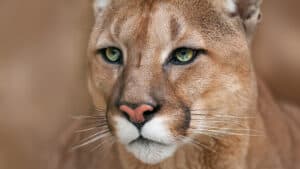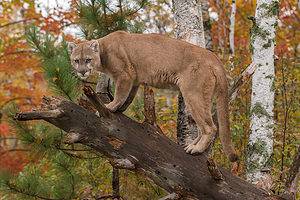Cougars, pumas, and mountain lions, oh my! Depending on where you live or what you are watching, you may hear America’s big cat called by a number of different names.
Are there differences between cougars and mountain lions? Where do they live? Keep reading to find out.
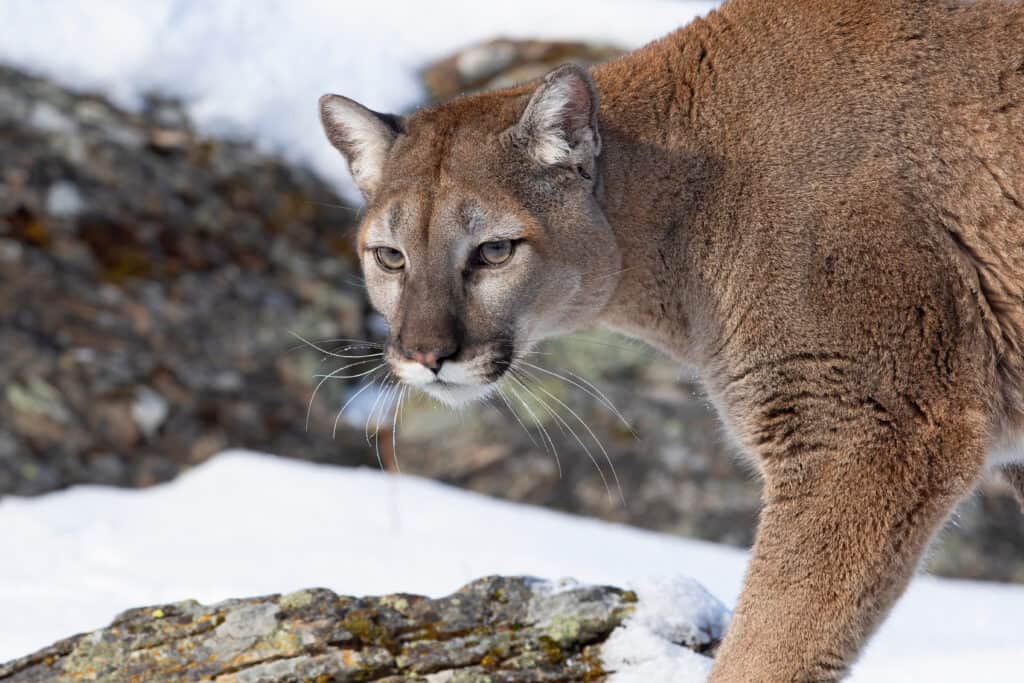
Cougars and mountain lions are actually two different names for the same animal!
©Jim Cumming/Shutterstock.com
Cougar vs. Mountain Lion
Mountain lion and cougar are actually two different names for the same animal. Cougars have a very large range spanning much of North and South America. Different groups of people called them by different names.
Comparing Cougars vs. Mountain Lions
The same descriptive features apply to this animal, whether you call it a mountain lion or a cougar. Here are some fast facts:
Scientific name – Puma concolor
Common names – Mountain lion, cougar, puma, panther, painter, catamount
Size – 2.8 to 5 ft (86 to 155 cm) in length, 75 to 158 lbs (34 to 72 kg)
Habitat – Mountains, forests, deserts, swamps
Range – North and South America
Lifespan – Up to 20 years
Body – Feline
Temperament – Stealthy, solitary
The term “mountain lion” is most often used for the North American subspecies (Puma concolor cougar), and “cougar” for the South American subspecies (Puma concolor concolor). Begin from the same species, the differences between these cats are slight, but include:
| Mountain Lion | Cougar | |
|---|---|---|
| Range | North and Central America | South America |
| Overall Size | Slightly larger | Slightly smaller |
| Diet | Deer | Wild camelids |
| Climate | Cool | Warm |
| Coloration | Silvery | Reddish |
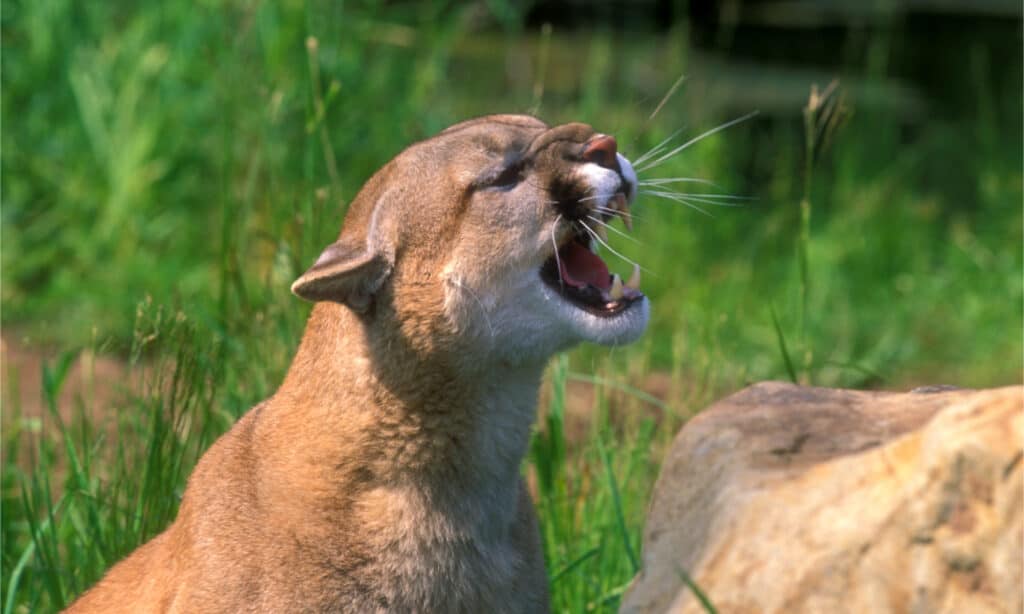
Mountain lions weigh twice as much as cougars.
©Chris Alcock/Shutterstock.com
Key Differences Between Cougars and Mountain Lions
Cougars and mountain lions are the same species, Puma concolor. This big cat has the largest range of any land mammal (besides humans) in the Western Hemisphere, so it is not surprising that isolated populations developed into subspecies. These include:
The North American Cougar
Classified as Puma concolor cougar, this subspecies ranges from Canada to the southernmost reaches of the United States, through Mexico and Central America, and possibly into South America.
The Florida Panther
This subspecies was once found throughout the southern United States. Nearly hunted to extinction, around 50 individuals now live in southern Florida. Conservation efforts seek to help this population make a comeback. Florida panthers are generally smaller than their western cousins. Though distinct, it is still part of the Puma concolor cougar or North American cougar subspecies.
The South American Cougar
This subspecies is classified as Puma concolor concolor. It is known to reside in the South American countries of Argentina, Brazil, Chile, Colombia, Peru, and Venezuela.
Consider these differences in more detail.
Range
North American mountain lions range from Canada, across the American West, east to the Florida panhandle, and into Central America. Some populations are believed to reside in South America as well.
The South American cougar lives throughout South America, including Brazil and the Andes Mountains.
Overall Size
Adults of the Florida panther and South American cougar varieties may weigh only half of what adult North American mountain lions weigh.
Diet
Cougars and mountain lions are opportunistic predators. They’ll take whatever mammals and birds they can catch, but diets vary somewhat based on the prey available in each geographic region. Mountain lions eat lots of deer and mountain sheep. South American cougars hunt wild camelids including the llama, alpaca, vicuña, and guanaco, as well as the capybara, the world’s largest rodent.

The cougar likes to inhabit tropical forests.
©BorneoRimbawan/Shutterstock.com
Climate
The mountain lion generally lives in cooler mountainous regions, while the cougar inhabits tropical forests. Again, the exception to this is the Florida panther of the northern subspecies, which dwells in hot, humid, swampy habitats.
Coloration
All cougars have a tawny coat with a lighter underbelly. However, differences in coloration are seen depending on the climate. Mountain lions may have silvery, slightly longer fur, while cougars from warm areas – the Florida panther and the South American cougar – have a more reddish coloration.
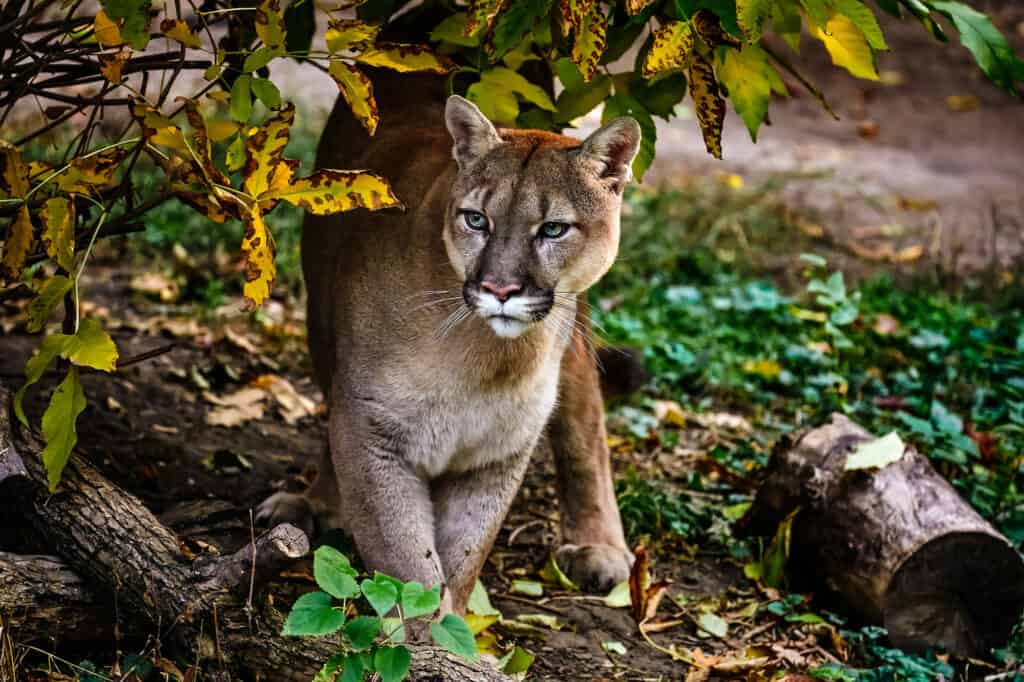
Cougars and mountain lions tend to run away or hide rather than attack humans.
©Evgeniyqw/Shutterstock.com
Is It Normal For Cougars And Mountain Lions To Attack Humans?
Both cougars and mountain lions have been reported to have attacked humans, though this occurrence is rare. They are afraid of encounters with mankind and are more likely to run away or hide than to attack. In North America, only 126 attacks from a mountain lion have been recorded in the last 100 years, with 27 of those attacks being fatal. If one does happen to attack, it is likely due to loss of territory, lack of food, or the mountain lion viewing the human as prey.
Bonus: Do Bobcats Attack Humans?
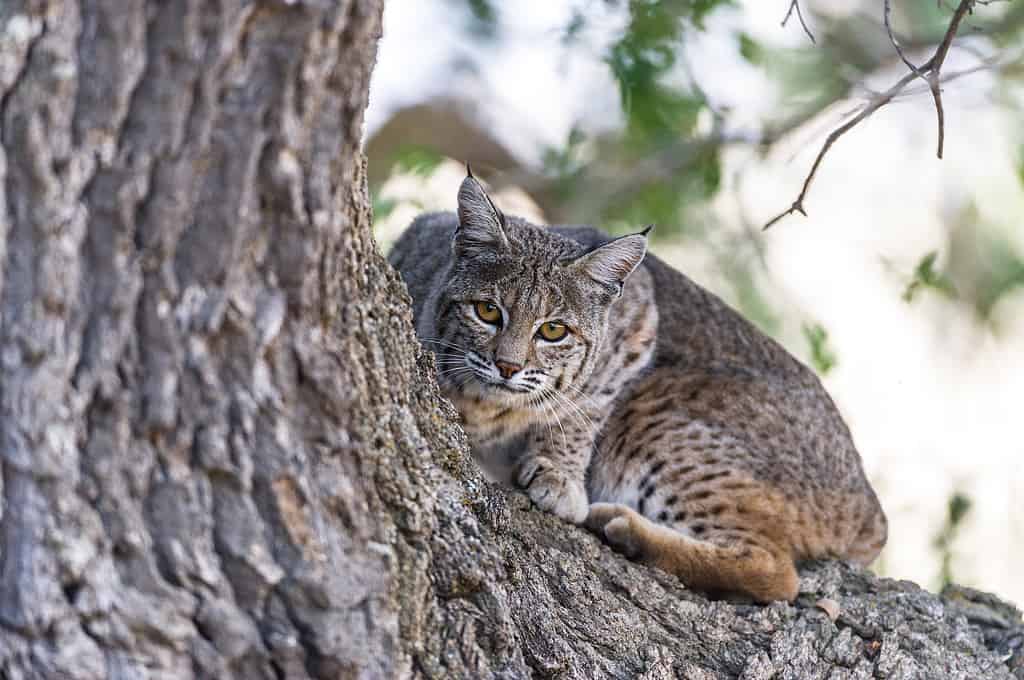
It’s very rare for a
bobcat
to attack a human, but they will prey on small, unattended pets if given the chance.
©iStock.com/brentawp
We’ve investigated facts surrounding mountain lions, as well as the threats they pose to humans. Another large cat that lives in the wild in parts of North America is the bobcat. Do bobcats pose a similar threat to humans? How often do they attack, and are they as dangerous as mountain lions?
Bobcats (also called lynxes) are smaller than mountain lions, typically weighing between 15 to 40 lbs. Sometimes bobcats are comparable in size to larger domestic cats, weighing up to 20 lbs. Due to their size, they feed on smaller prey like rabbits, birds, squirrels, rats, and chickens. They would not likely view a large human in terms of a potential meal. However, they can be drawn to yards by unattended small pets, which are attractive prey to bobcats.
Other things that can attract bobcats to your property include:
- Bird baths
- Pools
- Fountains
- Water for livestock
- Food for livestock
- Space underneath decks
- Thick brush and shade
- Unoccupied yards to sunbathe in
Bobcats usually run away from a human. If you encounter one, the best thing to do is face the bobcat, stand your ground (don’t flee), and make noise. Do not, however, purposefully approach a bobcat. If a bobcat boldly approaches you, it may have rabies. While reports of bobcat attacks on humans hardly exist, there was a resident of Saddlebrooke, Arizona, who suffered a bobcat attack. Authorities believed it to be rabid, but it was not successfully captured to prove as much. The man bitten was forced to undergo a full round of rabies treatments to protect him from potential infection.
In summation, bobcats do not pose the same threat to humans that mountain lions do. As long as you react appropriately if an encounter with a bobcat occurs, you’ll likely walk away unscathed. The chances of being attacked by a mountain lion are greater.
The photo featured at the top of this post is ©
FAQs (Frequently Asked Questions)
Is There a Difference Between a Cougar and a Mountain Lion?
Yes. Cougars and mountain lions are the same species of big cat, Puma concolor. They are, however, of different subspecies.
Why Are Cougars Called Mountain Lions?
In a native South American language, the cat was called cuguacuarana. Settlers shortened the word to “cuguar,” and later altered the spelling to “cougar.”
When settlers from Spain came to North America, they called the cougar gato monte, meaning “cat of the mountain,” as well as leon, the Spanish word for lion. These terms described both the cougar’s appearance – similar to a female African lion, but smaller – as well as its mountain habitat. In English, these terms were combined to form “mountain lion.”
What Other Names Are Used for Cougars and Mountain Lions?
The Incas called mountain lions “pumas.” “Panther” was a term used by Europeans to describe big cats with a solid coat. This name was thus given to the sandy-colored cougar as well as a related species, the solid black morph of the jaguar. In some places, they are also called painters or catamounts.
Thank you for reading! Have some feedback for us? Contact the AZ Animals editorial team.



